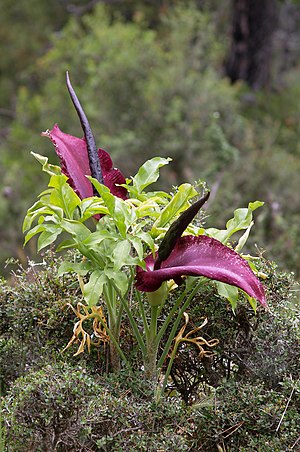Dracunculus vulgaris: Difference between revisions
Κύριε, βοήθησον τὸν δοῦλον σου Νῖλον κτλ. → Lord, help your slave Nilos ... (mosaic inscription from 4th-cent. church in the Negev)
mNo edit summary |
mNo edit summary |
||
| Line 5: | Line 5: | ||
}} | }} | ||
{{lael | {{lael | ||
|lgtx=[[ | |lgtx=[[ἀγχομανές]], [[ἄμι ἄγριον]], [[ἄρον]], [[ἀρωνία]], [[ἀσκληπιάς]], [[αὔγειον]], [[ἄφρισσα]], [[δορκάδιον]], [[δρακόντιον]] | ||
}} | }} | ||
{{trml | {{trml | ||
Revision as of 15:59, 2 February 2024
Wikipedia EN
Dracunculus vulgaris is a species of aroid flowering plant in the genus Dracunculus and the arum family Araceae. Common names include the common dracunculus, dragon lily, dragon arum, black arum and vampire lily. In Greece, part of its native range, the plant is called drakondia, the long spadix being viewed as a small dragon hiding in the spathe.
This herbaceous perennial is endemic to the Balkans, extending as far as Greece, Crete, and the Aegean Islands, and also to the south-western parts of Anatolia.
Latin > Greek
ἀγχομανές, ἄμι ἄγριον, ἄρον, ἀρωνία, ἀσκληπιάς, αὔγειον, ἄφρισσα, δορκάδιον, δρακόντιον
Translations
Dracunculus vulgaris
Arabic: لُوف الحَيّة, لُوف الجَعْد, لُوف جَعْدِيّ, لُوف أَرْقَط, لُوف كَبِير, صَرَّاخَة, فِيلْجُوش, طُرْقُنْطِيَة / طَرْقِنْطِيَة, خُبْز الْغُرَاب, دْرَاقُنْطِيُون, قُلُبْرِيَالَّة; Catalan: dragoneta, colobra, dragontina, dragontea, serpentària; Finnish: kreikanlohikäärmevehka; French: gouet, serpentine / serpentaine / serpentaire, coulevrée; German: Drachenwurz; Greek: δρακοντιά; Ancient Greek: ἄφρισσα, δρακόντιον, ἄρον, ἀρωνία, ἀσκληπιάς, ἄμι ἄγριον; Latin: dracunculus, colubrina, serpentina / serpentinaria, viperina, dracontea; Latin: Dracunculus vulgaris; Ottoman Turkish: ییلان یاصدغی; Persian: فیل گوش; Serbo-Croatian: zmijinac, zmijavčica and zmijavičica; Spanish: dragontea, zumillo, dragoneta; Turkish: yılan yastığı

